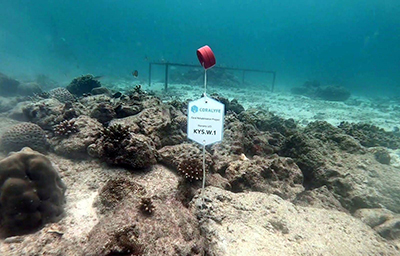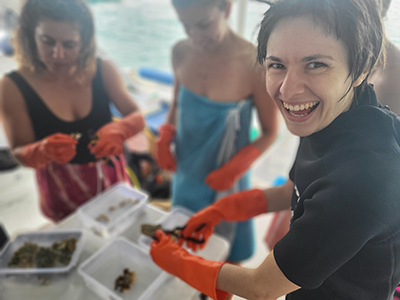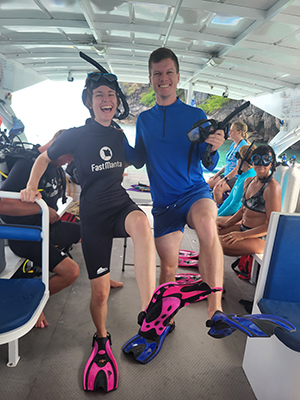You want to discover the breathtaking underwater world and do something good at the same time? Then plant corals together with a marine biologist. On this special mission you will learn all about these unique animals and make a real IMPACT on your sustainable diving adventure. I checked out the organisation
Coralyfe for you. Here I tell you what you can expect from this coral conservation workshop and snorkelling trip in Thailand. Curious? Well, all aboard.
"Today we have the big boat because another group has booked the coral course," Andy, the Italian marine biologist, says happily and leads us on deck. The diving instructor has made his passion his vocation. Together with his organisation Coralyfe, he informs Thais and holidaymakers about the importance of corals for the ecosystem. He combines environmental activism with two tourist highlights: snorkelling and scuba diving with equipment.
As we chug out of the harbour, the interactive workshop begins immediately. "What is a coral anyway?", Andy wants to know from us. "A plant?", I ask uncertainly. "Almost. It's alive and not a rock, right." A Portuguese woman knows the right answer: "A coral is an animal." I must have been asleep in biology class.
I learn that an animal is a single polyp. It looks like a small flower or like a jellyfish - only turned upside down. Several polyps make a colony. So when we think of a coral, we often think of a colony of polyps.
Less than 0.1% of the ocean is populated with coral reefs. Yet 30% of marine life:inside depends on these few colonies for food sources and shelter. The remaining animals are in turn dependent on these 30%. An eternal cycle that must be preserved. Besides Coralyfe, there are other organisations such as
Coral Guardian in Spain and Indonesia that are dedicated to this mission.
When we reach the island, instead of an anchor we throw the diver Jai into the water. Okay, that was a little joke. However, Jai actually jumps into the sea with a rope. So that our anchor doesn't break the colonies, the diver ties the boat to the placed bottom hook. Then we follow him into the cool water. Andy asks the scuba divers to collect broken, living corals and stones. We will need these later for the workshop. The snorkellers among us - including my friend Flo and me - explore three of the so-called nurseries. There are the coral babies they planted the last few times. I am completely enchanted by the biodiversity of the fish and the colourful colonies.

Back on board, the practical part of the workshop begins. We want to prepare the colonies so that they can continue to grow. For this we need a stone and a piece of coral that has already broken off but is still alive. If we had not used these broken off reef shards, they would have been buried by the sand and died. We save them from this fate and give them a new home. With a pair of pliers we cut off some of the coral. Sometimes we also have to use a chisel. In the end we have about 80 slivers that serve as our "seedlings" or "young plants". This coral gardening, as Andy calls it, reminds me of gardening at home. Similar to pruning trees, one should also pinch off the "coral branches" as close to the main branch as possible. My parents would be proud of me.
Andy shows us how to find the perfect spot for the coral on the stone. This is even better than playing Tetris. But it looks easier than it is. When we have found a suitable crack, we glue the piece in place using super glue. Crazy, isn't it? We simply glue the seedling to the stone. Superglue is non-toxic and contains similar active ingredients to wound glue. Andy learned this gluing method from Anur Abdullah, the founder of
Ocean Quest. What makes this approach special is that the reef is not artificially made from plastic pipes, pieces of concrete, old tyres or metal scaffolding. "No one method is better than the other. I just prefer to use local resources. In the end, what matters is that we help the corals," Andy emphasises.
As soon as we are done, the stones with the coral babies are returned to the ocean. "Bye, bye, baby corals. They always grow up so fast," joke instructor Rewa and I as Andy takes them to the nursery. In reality, however, these colonies take quite a long time to grow up. It depends a lot on the species and types of coral. The plate and branch corals here take 2-3 weeks before they no longer need the support of the glue and have firmly attached themselves to the stones. Within 12 months they can reach a width of 10 cm. "Some of our 5-year-old colonies are now around 30 cm or more in diameter, but again it's very species-specific and individual," Andy explains.

Unfortunately, they are threatened by some dangers. The most well-known phenomenon is coral bleaching. What may look like a marble work of art is actually a starving colony. "There is no one cause. It's due to several factors," Andy explains, "In Australia it's mainly due to the heat. Here in Ao Nang it's the water pollution and the amount of sand that's burying the animals."
Other risk factors for marine animals include cement deposits, water pollution and aggressive sunscreens. My tip: Buy a coral-friendly sunscreen before your next beach holiday. It protects twice as well. Mass tourism also plays a big role. Careless tourists kick the ocean dwellers to pieces, mistaking them for stones. Others carve their names on the reefs, like on a tree trunk.
I prefer to immortalise myself in this blog and share with you this unforgettable snorkelling adventure. That day we repopulated 3 square metres with 62 rocks full of small corals. This is a completely new reef. Best of all, we can watch our babies grow as Andy will be sending us regular updates. I'm really excited to see how the little ones develop.
"It's only thanks to you guys that we can do all this," Andy emphasises at the end as we make our way back. If you also want to contribute to an IMPACT, feel free to support similar programmes like Coralyfe. Already a diving professional? Then let Ocean Quest train you as a
Coral Ambassador. Want to support marine wildlife from home? Adopt or give a coral as a gift to your loved ones.
Best regards,
Yours, Franzi









